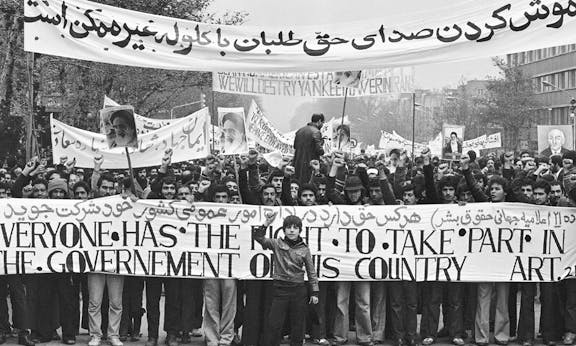Explaining US hostility to Iran

The Trump administration is famous for its abusive tweets and infantile militarism. Yet no country suffers under such persistent and active hostility from the US government as Iran.
In the first two years of his presidency, Trump has threatened to declare war against Iran on numerous occasions, even glibly suggesting it could be annihilated. While he has yet to act on these menacing thoughts, he has ripped up Obama’s nuclear deal and re-imposed horrific sanctions on the country, and anyone who does business with it.
Trump’s trade advisor has endorsed this policy of “economic and military pressure”, describing it as a strategy for achieving “peace through strength”. John Bolton, Trump’s nutty national security advisor, recently wrote an article for the New York Times demanding that the US bomb Iran and “vigorously” support “regime change”. These terrifying arguments should be taken seriously, coming as they do from the man who helped to organise the destruction of Iraq in 2003.
So why does his hard right administration despise Iran so much?
The beginning of the answer can be found in the 1979 revolution that overthrew the Shah, the US-backed dictator. Often called an Islamic revolution, the movement was actually a coalition of workers, women, students, oppressed nationalities and the poor, who organised workplaces and communities across the country.
It was only with great difficulty that the Islamists hijacked the revolution, which required crushing the working class and the social struggles that sparked it. They were assisted greatly by the Stalinist politics that dominated the Iranian left.
By overthrowing the Shah the revolution ended a decades-long alliance between the US and Iranian governments. The relationship was based on oil extraction, Iran’s strategic location at the mouth of the Persian Gulf and the Shah’s militant anti-leftism. The regime was rewarded with huge amounts of foreign aid, and the Shah’s family enjoyed all the pomp and grandeur associated with being a key US ally.
The new Islamist regime was immediately isolated, invaded by Saddam Hussein’s Iraq, which was funded by the Americans and the increasingly powerful Saudis. The war left a profound impression on Iranian society, establishing Iraq’s status as the country’s bête noir and allowing the new regime to galvanise support for itself on a cynical anti-imperialist basis.
Despite its rhetorical opposition to US imperialism, the Iranian government welcomed the first Gulf War as an opportunity to weaken its Iraqi rival. This led to a thawing of relations at a regional level, including the official re-establishment of diplomatic dialogue with the Saudis later that year.
Presidents George H.W. Bush and Bill Clinton were unmoved by these developments, however, and continued to undermine the Iranian regime. The Democrats under Clinton imposed the current policy of total sanctions, in 1995, partly as punishment for Iranian criticisms of the Oslo accords. The consequences for the country have been brutal, with acute shortages of medical supplies and food accompanying a more general economic impoverishment.
The Iranian government campaigned strongly against the 2003 invasion of Iraq because it would bring the power of the US military machine to its borders. Yet much evidence is that at least sections of the government secretly welcomed the removal of Saddam Hussein and prepared to intervene to increase Iranian influence in the country.
This pragmatic realpolitik highlights the dubious nature of claims that the Iranian government (or any other capitalist government) is genuinely anti-imperialist.
After years of civil war, the highly sectarian Iranian-backed Shiite forces in Iraq won a series of problematic elections and took power. They came to an agreement with the US regarding the governance of the war-torn society, but from a position of power. The US army had been publicly humiliated. This new alliance was a pragmatic one, neither side feeling any great love for the other. Indeed, the Americans were furious.
In the following years, Iranian influence further expanded through Lebanon and Palestine via Hamas and Hezbollah. The latter inflicted a great defeat on the far superior forces of the Israeli military, giving the US and its Israeli allies yet another reason to be angry.
Through this period and the aftermath of the Arab Spring, the Iranians expanded their political influence through Iraq, Syria, Lebanon, Palestine and to some extent in Yemen. This growing strength on the ground, combined with the presence of neoliberal “reformers” in the Iranian government from 2009, opened the possibility of rapprochement between president Barack Obama, who wanted a US “pivot to Asia” to contain China, and an Iran desperate to end its economic isolation.
This was the political basis for the much discussed but little understood nuclear deal between the US and Iran. Yet the deal, signalling the acceptance of Iran as a powerful player in Middle Eastern affairs, faced opposition among the US political establishment, including Hillary Clinton and Donald Trump.
The hostility represented far more than a refusal to face facts. The decades-long diplomatic strangulation of Iran was a product of and reinforced the US’s strategic alliances with Israel and Saudi Arabia.
The social, political and economic connections to the ruling classes of these nations, Iran’s implacable enemies in the Middle East, cannot be swept aside by a diplomat’s pen. They are embedded in the people, the institutions and economic processes that bind the three nations. The Iran deal offered only the possibility of a future relationship with Iran, while the damage done to these pre-existing alliances was immediate.
The Trump administration, representing the most violent impulses of a weakened but undefeated US imperialism, is returning to what every empire understands best: force. In this context, any country that refuses to play by its rules is in the firing line.
That has been the fate of Iran for 40 years.